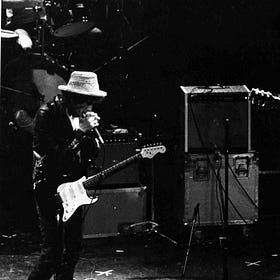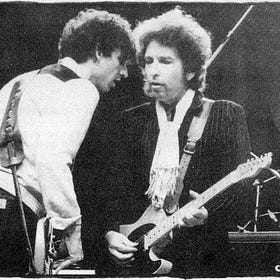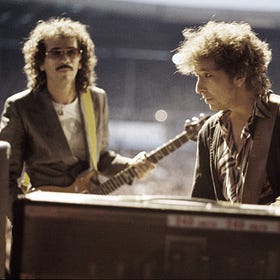The Men Who Put Bob Dylan and Santana in Stadiums
'Real Live' Promoter Interviews #1: Thomas Johansson, Scandinavia

This summer marks the 40th anniversary of Bob Dylan’s enormous summer 1984 European tour with Santana, which became the album Real Live. To celebrate, I’ve got a number of different ‘84-themed posts coming. Three of them are new interviews with the people who worked behind-the-scenes to put on these giant shows: The promoters.
Each of the tour’s 27 massive stadium shows was presented by American concert impresario (and Santana’s manager) Bill Graham in partnership with a local European promoter, generally the biggest one in their region. I’ve spoken to three of them, and will be rolling them out one-by-one this month. Their names on the concert posters may appear real small in the fine print, but they played a huge role in making these shows happen, and had no shortage of behind-the-scenes stories to share.
Also, they all worked with Bob at other points too, so even though the ostensible reason for our conversations was the Real Live tour turning forty, we delved into their other Dylan-related work on everything from Live Aid to the Nobel Prize.
Subscribe if you don’t already to get the full set delivered right to your inbox (note: one of the three, and some other special 1984 content, will be going to paid subscribers only)
Going in rough chronological order, we kick things off today with Thomas Johansson, who oversaw the tour’s two Scandinavian shows, in Gothenburg, Sweden on June 9, and Copenhagen, Denmark on June 10. The days he is the chairman of Live Nation Nordics, but at the time he was running the live-entertainment company EMA Telstar. He often gets credited as helping introduce the world to ABBA; he traveled the world with them producing and promoting every show they did from winning Eurovision through their breakup. Ever since, practically every major artist who has played shows in Scandinavia has gone through him.
Below, we talk about those two enormous Dylan-Santana 1984 shows, as well as what it was like to work with Bill Graham, the difference in ticket pricing between Europe and America, and the role he played in telling Dylan he’d won the Nobel Prize.
Was the ‘84 tour the first time you had worked a Bob Dylan show?
No, I did a very early Bob Dylan show here in Stockholm in [1966], when he was half electric, half acoustic, with my partner at the time Knud Thorbjörnsen. I wasn't the promoter; I was just the guy who helped the promoter, because I was too young to be a promoter at that time. Then actually, after this show in 1984 with Santana, I've done every Bob Dylan show in the Nordic Hemisphere.
Do you remember anything in particular about that ‘66 show?
I don't unfortunately. But these [1984] shows I remember quite well because the tour was set up by Bill Graham, and I did a lot of stuff for Bill before this. I did Santana for Bill before this; I met him and I met his people in San Francisco in the late ‘70s. Bill promoted an ABBA show for me in San Francisco in 1979. I did all of ABBA concerts worldwide. I did all the shows everywhere between 1974, when they won the Eurovision Song Contest, and when they finished off in Budokon in Tokyo in March of 1980.
So it's like a role reversal compared to this '84 tour. For ABBA, you’re worldwide doing them all and he's the local guy in San Francisco.
Yeah, but in 1984 I was a promoter with Bill being the tour producer.
Can you explain for the layperson what the difference is? What's the division of labor?
When I did ABBA with Bill, I was the tour producer. I produced all the shows, and I was the co-promoter with most of the promoters worldwide. Bill Graham was a promoter for me at Concord Pavilion. When he then put the Santana and Bob Dylan package together, he asked me if I wanted to do it in the Nordic region. I did Gothenburg, Ullevi Stadium, and Copenhagen, Idrætsparken Park, for him. So he produced the whole tour; I was the promoter in Scandinavia.
What was working with Bill Graham like?
Bill was a dear friend and a mentor of mine. I must say he taught me a lot. In 1982, I did the Rolling Stones with Bill. That was a big, big eye-opener for me because we'd never done stadium shows up here before. The 1982 shows with the Stones were the first big stadium shows ever in northern Europe.
Must have been quite a leap to start doing stadium shows for the first time there.
We opened up the stadium in Gothenburg in 1982 with the Rolling Stones and then in 1983 I did David Bowie. Then in 1984 I had the opportunity to pick up the Santana/Bob Dylan shows, and in 1985 I did Bruce Springsteen and the E Street Band.
Local news reports on the non-Dylan shows (in Swedish, but good footage of the bands and scene):
What do you remember about the two shows themselves, the one in Gothenburg and Copenhagen?
Gothenburg I remember that Bob's guitar player, who was the guitar player with the Stones for a while [Mick Taylor], we had to get him to a dentist. He had a very big dental pain and we had to get him to a doctor for that.
I also remember the press reception to open up the whole European tour, because Bob then was supposed to play the old amphitheater in Verona. All the European promoters were asked to come there with one press guy, and we got a beautiful concert in the Arena di Verona.
Was that typical, that you would be asked to travel somewhere else to see a different show?
No, it was the way that Bill set it up. With the Stones, that opened up in Holland, we all went to Holland. With David Bowie, we all travelled to Lyon. Because a lot of people had never done a big stadium show before, and Bill wanted everyone to be on the same page. Bill was very specific with how we wanted the show to run.
What specifically did he want?
He was very specific with the fact that you need to take care of the audience in a proper manner. The way that people queued up, the way that people were treated. They should be treated like human beings. It was a bit of the, you know, love, peace and understanding. He said if people queue up early and it's hot, you've got to bring them water. If they queue up early and it's cold, you've got to bring them blankets. All of these things that, when you promoted concert halls or arenas, you didn't really have to think about that. But when you have 50 or 60,000 people queuing up for a show outdoors, you need to think about a lot of other things.
Also the way that you looked after the artist, which for me was fine, but a lot of people never understood. Like when Bob played Copenhagen, you had to walk quite a bit from the dressing room area under the grandstand to get to the stage. Bill and I walked there about 20 minutes prior to when Bob was going to go on stage, and there was hangers-on and crew that had smoked, and there were stogies on the floor. Bill said to me, "Thomas, you can't have the artist walk here.” So we run after a broom and we broom the area where Bob was going to walk. That was a very typical Bill Graham move.
The details. Sweat the small stuff.
Oh yeah, absolutely. It is all in the detail.
The show itself, we started off with Santana, Carlos did a wonderful set and then Bob came on a little bit late, maybe 10, 15 minutes. Then he delivered a very typical Bob Dylan set.
Did you have much interaction with the artists themselves, Dylan or Carlos?
I always had a lot of interaction with Carlos because I knew him from before. He's a lovely guy. Bob basically, I said hello. He asked me a few specific things about Gothenburg from when he played before in the arena.
You mean just about the city, about the culture?
Well, he knew quite a lot about it, so it wasn't like he didn't knew about the culture, but he did ask me some specific local things about Gothenburg.
Many moons later, I worked with the Swedish Academy who give out the Nobel Prize. And I had the pleasure of calling Bob's lawyer and manager Jeff Rosen and the person who has done Bob's tours, Jeff Kramer, and telling them that Bob Dylan has been given the Nobel Prize in literature.
No kidding. You were the guy who made that call?
Yes. I called Jeff and Jeff. That's a big thing with a king, there's like a dinner for 300 people, it's a really big thing here. But Bob unfortunately couldn't make the prize that day. So the US ambassador, Azita Raji, a good friend of Barack Obama, gave a lovely speech [that Dylan had written].
Then eventually Bob came and picked up a prize at a concert I did for him in Stockholm a few months later in April. The Swedish Academy came to the show. I set up a room for the Academy. Bob came, he heard a little speech, said hello to the 12 members of the Academy and received the prize.
All's well that ends well I suppose, but were you at all miffed at the time when there was all sorts of drama about him not commenting on it at first?
No, I wouldn't say so. He had a legitimate reason not to come to the actual prize ceremony. I knew that he wanted to pick up the prize, so I knew he would come and pick up the prize when he played here. He opened his tour here in Stockholm, which was perfect.
What does it mean when you say pick up a prize? What actually happens?
The 12 members of the Academy are there waiting for him in a small room. The president of the Academy, I introduced them, he gave quite a funny little speech, gave Bob the Nobel Prize. We had a glass of champagne and Bob thanked them and that was it.
Do you still do Dylan concerts when he plays up there?
Absolutely.
So this is 40-- well, if you include that ‘60s show, it's 60 years.
Yeah. I was very young then. But you know, I still believe that Bob Dylan is maybe the artist that in 200 years, we'll talk about him. To me, he's such an important force of modern music, and I think that his latest album that he did is an absolutely fantastic album.
He played a couple times in Sweden two years ago touring Rough and Rowdy Ways. Did you work those as well?
Of course.
What do you remember about those shows?
We had a chat after the show. We talked basically about COVID, because it was right after. He asked me how that was in Sweden, because he knew that it was being dealt with in a different way in Sweden than a lot of other countries. We never closed down our society. We kept it quite open. You could go to restaurants and bars and things. We couldn't do any shows, but I went into the office every day. So we talked about that.
You've done so many shows with him, but any other shows or interactions that stand out?
When he picked up the prize, he did two smaller shows, like 2,700 capacity, two nights. That was fantastic. Incredible shows.
There's this famous show in Horsens in Denmark in 2000. One of the smallest places he ever played. Was that one of yours?
Oh, yeah. I wasn't there, but we promoted the show. He played for me a small show in the city of Karlstad, just prior to COVID. That's like a 1,300 capacity room. That's the smallest show I've done with Bob—
Well, that's not true. I've done a smaller show with him. He wanted to play a club prior to playing the arena in Stockholm [in 2009]. He played Berns, which is like a 1,000 capacity club.
That's a big change from the stadium with Carlos. You've done both ends, the biggest places he's ever played and the smallest.
I think so. I remember the show in Karlstad where I had the opportunity to sit down and watch the show. That was also a mind-boggling show. He was so good. He played so well.
You did a couple of the Dylan/Petty shows too a few years after the Santana one, right?
I remember them being fantastic shows. We did both Helsinki and Stockholm. I love Tom Petty. Again, with Tom, we did his first show. He was opening up for Nils Lofgren in a theater in Lund in the south of Sweden.
Going back to '84, and I'll let you go in a minute here, those are huge places with him and Carlos. How did they do financially?
Sold out.
They could fill that big of a place in '84?
I have a habit with Bob to sell out his shows.
I mean, in a 1,000 room, that's probably not as hard, but those stadiums are—
No, no. In a 1,000 room, you go out on the street, you shout loud, and you sell the tickets. For a big place like that, because the way we had set it up, 1982, we did two nights with the Rolling Stones. 1983, I did two nights with David Bowie. Then I followed that one night with Carlos Santana and Bob Dylan, and then I followed that with two nights with Bruce Springsteen and the E Street Band.
I think that because we started to do stadium shows, there became a thing where people wanted to be there. They wanted to be a part of that. Then, of course, when you play big places like that, you can keep the ticket prices relatively low so that everyone can afford to see the show.
Oh, I wouldn't have thought of that.
You're American. I've been with Live Nation since I sold my company, EMA Telstar, in ’99. It's a totally different way of looking at ticket pricing in America and Europe. There's a big cultural difference there. It's always been like that, but it happened more and more.
I also have had the pleasure to work with my other favorite hobby, which is ice hockey. I've been representing National Hockey League in Europe since 1999, and I've done their games here. When we first introduced the ticket prices to NHL games, people thought the world was crazy. Because an NHL game in America is like $200, $300, right? And an ice hockey game here, with the top clubs, were maybe at the time when I started like $15.
When we started to do the big outdoor shows, I could present people with tickets for $10. A lot of these people couldn't afford to see a show otherwise.
I remember when Springsteen announced his current tour, which at this point was like two years ago, I saw some people were flying to Europe to see the shows there because, even with the airfare, it would be cheaper than buying a ticket to see a show in America.
Absolutely. We see that effect. We did the opening of Beyoncé's world tour here last year. Three nights at the stadium here in Stockholm. And we had about a thousand citizens of yours flying here. They said the same thing. It's cheaper for us to buy a [concert] ticket, an airline ticket, and stay in a hotel, than seeing her in a similar situation in the U.S.
Thanks Thomas! Learn more about his career at Pollstar or IQ Mag. Here are videos from the two shows:
1984-06-09, Ullevi Stadion, Gothenburg, Sweden
1984-06-10, Idrætsparken, Copenhagen, Denmark
Stay tuned for the next two promoters interviews coming soon. Only paid subscribers will get them both. Plus some other 1984 anniversary related interviews and content too.
UPDATE: Here’s part two:
"I still adore Bob Dylan. But don't tell Joan."
Today, the second in my series of interviews with three of the promoters who helped put on Bob Dylan’s giant Real Live stadium tour in 1984 with Santana and, at some shows including today’s, Joan Baez. (If you missed the first installment, it’s here).
In the meantime, some other 1984 tour content to catch up on:
Real Not-Yet-Live: Bob Dylan's 1984 Tour Rehearsals, Part 1
Rehearsal tapes always seem like a small miracle. How do tapes of private sessions where Bob Dylan is practicing with his band make their way online for us all to hear? I…
The Late Gregg Sutton Remembers Bob Dylan's 1984 'Real Live' Tour
Three weeks ago, I interviewed Gregg Sutton, the bassist for Bob Dylan’s 1984 tour immortalized on Real Live. I was planning to run it next summer to commemorate the tour’s 40th anniversary…
1984 Dylan/Santana Tour Program
A reader recently dug out the tour program for the 1984 Dylan/Santana summer tour and sent me scans (thanks David!). I’d never seen it before, and I suspect some of you haven’t either. I didn’t start seeing Dylan shows for another 20 years, and I don’t think I’ve ever seen an official program at any show






Fascinating!
I’m waiting for Dylan’s Sphere tour in Vegas.